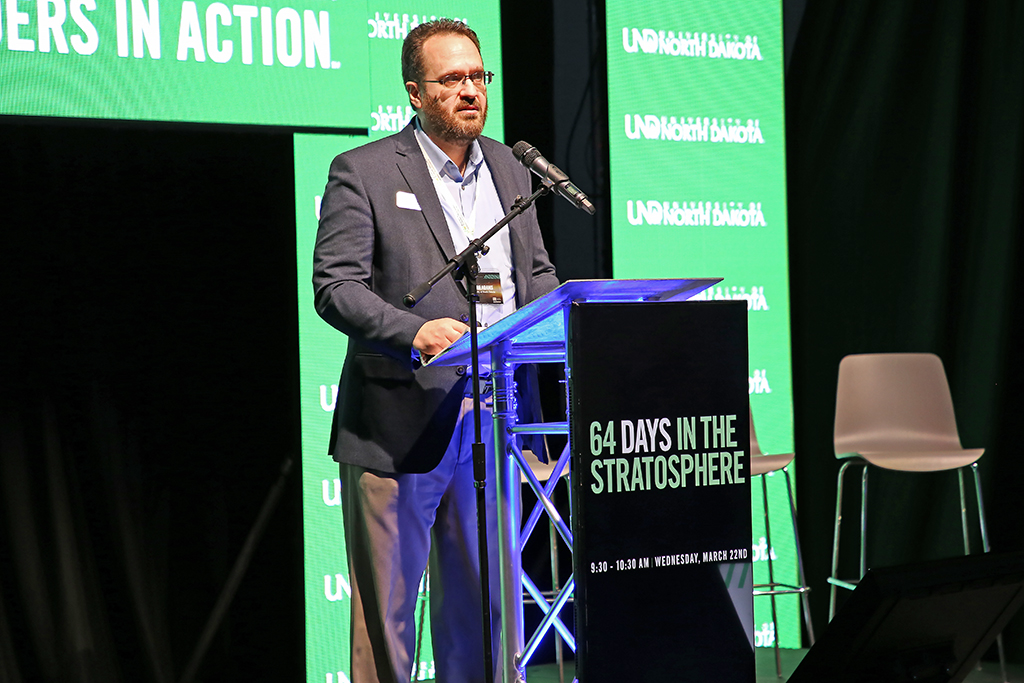UND SOaRS symposium’s flight plan: Make most of stratosphere

Inaugural symposium brings scholars, government officials and industry representatives together
On March 21 and 22, UND brought together academics, government officials and aerospace industry manufacturers all facing the same desire: developing the technology needed to harness the potential of long-term aerial operations in the stratosphere.
UND’s first-of-its-kind Stratospheric Operations and Research Symposium provided the forum for those aerospace and government leaders to interact, learn from one another and possibly collaborate on research. The specific topics of presentation and discussion were all things related to High Altitude Long Endurance aircraft (HALE) and High Altitude Pseudo Satellite (HAPS) development. The symposium was emceed by Robert Kraus, dean of the John D. Odegard School of Aerospace Sciences.
UND President Andrew Armacost, in his opening remarks, welcomed attendees, some of whom had traveled from nations such as Japan, Germany and the U.K., to a region that has been described as the epicenter of research and development of uncrewed aerial systems.
“Let me thank everybody in the room for being here today, for sharing in the rich discussion and for taking advantage of the chance to push the boundaries of science and uncrewed flight,” Armacost said.
In his remarks, Armacost described the extent of UAS ecosystem in Grand Forks, which includes UND, Grand Forks Air Force Base (the home of the Global Hawk—the Air Force’s high altitude long endurance UAS), the Northern Plains UAS Test Site and the UAS business park Grand Sky. The latter features anchor tenants Northrop Grumman and General Atomics, two premier aerospace equipment developers.

Sen. John Hoeven, R-N.D., was also on hand to help kick off the inaugural event. He spoke of the growing UAS ecosystem, in particular recent developments that will allow new companies to come to Grand Sky and fly under the existing Federal Aviation Administration waiver the Test Site has been granted for beyond visual line of site flight. This development will allow those new companies to get enough airtime to show the FAA they can safely fly their aircraft, and thus be granted individual BVLOS waivers of their own.
But Hoeven also spoke of more weighty matters, including the recent flights of unidentified aerial phenomena (UAP) across the national air space. The federal government is calling some of those UAPs Chinese spy balloons, one of which was shot down over the Atlantic Ocean on Feb. 4, with another having been shot down on Feb. 11 over Lake Huron. Yet another was shot down over Alaska.
Hoeven spoke of what the stratosphere means to national security when it comes to UAPs, and how symposium attendees can lend their expertise in developing systems that can remain in flight in the stratosphere for extended periods of time—think months, not days. The point is to have continuous eyes-in-the-sky to identify those UAPs, as well as broaden the nation’s intelligence, surveillance and reconnaissance capabilities.
And, Hoeven said, academia, government and industry researchers each bring a different piece to that puzzle. But where will they put the pieces together?
“I submit to you it’s right here,” he said. “It’s right here because that’s what we do, and we do it over and over and over again.
“We get it done; we don’t just say ‘someday,’ ” the senator continued. “We do it, and we do it expeditiously.”
Why the stratosphere?
The stratosphere lies atop the atmosphere’s lowest layer: the troposphere, the layer in which clouds and weather — not to mention humanity— exist. The troposphere extends about 6 miles high where it terminates in the tropopause, a boundary layer to the stratosphere. The stratosphere extends about 30 miles high and houses the ozone layer, which is between 15-20 miles above the Earth’s surface.
To avoid turbulence, commercial aircraft will fly into the low stratosphere, while spy planes fly much higher. Certain weather balloons and HAPS balloons in development can go even higher.
Speaking shortly before the symposium, UND professor Hallie Chelmo told UND Today that certain atmospheric phenomena can alter the altitude of the lower boundary of the stratosphere. Recently, she said, that lower boundary extended down to the tops of mountains in Washington state, which would have given any mountain climber there the interesting honor of hiking in the stratosphere.
Communications is but one reason to operate in the stratosphere. Far above the weather, a HAPS aircraft (either lighter than air, such as a balloon, or heavier than air, like a fixed wing aircraft) can use communications equipment to provide connectivity and internet services directly to mobile devices or even first responders. This would prove useful in disaster situations, when communications have been lost; launch a high-altitude aircraft or balloon, and suddenly a smartphone has a signal.
“That’s part of what we’re trying to do because in the end, we’re trying to get the right information to the right people at the right time,” Kraus said.
Two researchers from telecom companies in Japan presented their ideas about a very light fixed-wing aircraft that can be used to provide internet service to rural areas, and eventually, they hope, even to supply wireless power to mobile devices—like a smart watch constantly maintaining its charge because of power transfer. The cost of the aircraft is cheaper than a terrestrial network, and they say companies could pass along those savings to customers.
And then there are military uses.
Communications or needed data for soldiers on the ground can be provided by a HAPS aircraft when line-of-sight comms fail because of terrain or other issues. A near stationary balloon can provide those needs, and due to relatively low cost per unit, can be easily replaced should it be compromised or malfunction.
Eric Follstad, requirements and technology division chief with the Resources and Analysis Directorate at U.S. Central Command (USCENTCOM), said stratospheric operations are critical for the military for a number of reasons, including being able to surveil those regions where groups adversarial to the U.S. operate. Follstad attended the symposium to discuss the importance of developing the stratosphere, and shared ideas on how industry representatives can efficiently present to defense officials, when seeking funding for their high-altitude projects.
Ultimately, Follstad said, it is cooperation that will that see the stratosphere developed.
“Within this audience, we can solve this stratospheric problem,” he said.

How can aircraft stay up there for so long?
The answer is with a little (or maybe a lot) of help from a UND alum. Noren Pan (also a Grand Forks Central graduate), president and CEO of Illinois-based Microlink Devices, Inc., said it was easy to get to the stratosphere, but tough to stay there. Not anymore.
Pan has developed a highly efficient solar cell (it resembles the negative from a film camera) that can be used to power a lightweight aircraft for, well, an almost indefinite flight time.
HAPS aircraft are by necessity light, and perhaps somewhat flimsy. They risk damage from weather when ascending to the stratosphere, but in the calm airspace there they can make use of the sun’s energy to stay aloft. During the day, the solar cells keep the aircraft flying. At night the aircraft runs on batteries, which then recharge when the sun rises.
Existing HALE aircraft such as the Global Hawk operate in the stratosphere but are expensive to operate and maintain. They also use aviation fuel, which has limitations. According to the U.S. Air Force, Global Hawks can fly for about 34 hours at a time. Pan’s solar panels were installed on the Airbus Zephyr, which in the summer of 2022 flew in the stratosphere for 64 days and change. Pan says stratospheric flight can go even longer.
“What we’re talking about today is something that can stay there for years,” Pan said.
That lengthy Zephyr flight originated in the southwestern U.S. Richard Tyler and Dave Wood, of AALTO HAPS, the company overseeing the Zephyr project, spoke about the important test flight. It required round-the-clock operations, and for such a successful flight, the crew, they said, actually grew bored. They wound up using flight-tracking software to draw pictures with the Zephyr’s flight path. Doodles included the liberty bell, a cowboy and written words like “SIXTY,” to mark the number of days over which the flight continued.
Tyler and Wood stressed the usefulness of the aircraft for both civil and military operations. It’s cost, at about $5 million, is considerably lower than that of a Global Hawk, which means the loss of one would not be a financial setback.
“You can land it as a lawn dart, then pick up the bits you need, fold it up, put it put it in a pickup truck and take it away,” Wood said. “It can be in an attritable system, and it can still have a lot more value than its current counterparts.”

Ryan Adams, associate dean for national security in the UND College of Engineering & Mines, told symposium attendees that he is interested in the stratosphere from the vantage point of looking down from space. He outlined the National Security and Space Initiatives at UND, which was funded by a $14 million investment from the Legislature.
UND’s focus on space overlaps with ground-based efforts to operationalize the stratosphere, Adams said. That space-based research and potential collaboration with partners both military and civilian will develop as UND’s National Security Corridor, based in Harrington Hall, comes online.
Included in the corridor will be digital and satellite engineering laboratories, as well as a satellite fabrication laboratory.
“A lot of this technology, a lot of these resources can be brought to bear for the High Altitude Long Endurance mission,” Adams said.
Written by Adam Kurtz // UND Today


